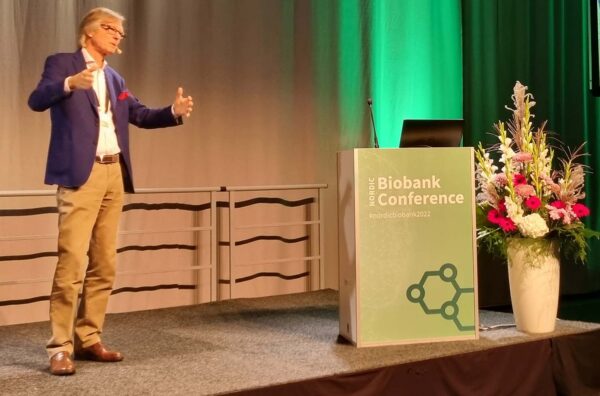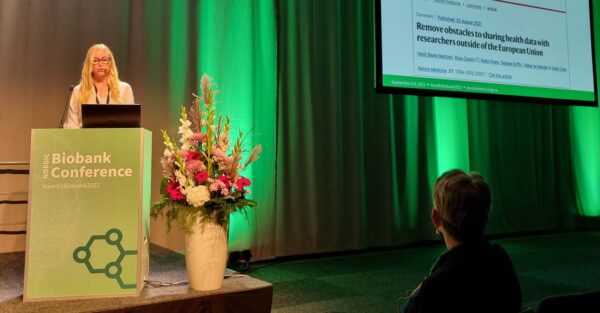Nordic Biobank Conference – an important step towards increased collaboration
The first Nordic Biobank Conference was organized in Gothenburg and can in hindsight be seen as an important first step on the way towards a joint future for Nordic biobanks. Focusing on current trends and challenges, the main take-away from the conference was the importance of continued collaboration among the Nordic countries.
Five hundred stakeholders from 21 different countries participated at the Nordic Biobank Conference in Gothenburg and even though the actual conference opened on September 7, the pre-conference day on September 6 was well visited and clearly appreciated by the attendees. Besides a fully booked crash course in the basics of biobanking, the pre-conference day included mingle and three separate workshops with topics ranging from quality management, automated storage solutions and education in biobanking.
Conference day 1
The official opening of the conference was a moment of joy but also relief as the event had been postponed twice because of the pandemic and the restrictions that followed. Linda Paulson, Head of Biobank Väst which organized the conference, summarized the situation during the opening session:
“We have had a Nordic committee for this conference who have met each other only through Microsoft Teams. Yesterday we met in person for the first time!”
Despite the many challenges when planning the conference, it all started off well in a festive atmosphere and with two highly interesting keynote speakers. The first one was Professor Aarno Palotie who presented the prestigious FinnGen project which was launched in 2017 and is funded by a Finnish public-private partnership. Palotie made it clear that the large funding of the project is a game-changer, especially for the digital tools which they use but he also highlighted the Finnish biobank act – a regulation which enables a clear advantage for biobanks in Finland compared to its Nordic neighbors. Despite the success in Finland, additional partners are needed for continued growth and Pelotie’s message was clear:
“The only way we can move forward is through collaboration, to work together towards a common goal.”

The second keynote speaker was Hilma Holm, head of Cardiovascular at deCODE genetics. She gave several examples of on-going studies and projects in Iceland with a clear emphasis on the importance of data. Among the many examples, she mentioned a previous large-scale whole-genome sequencing of the Icelandic population (2015) and talked about the deCODE post-Covid study.
The data-trend continued in the first symposium of the conference, headlined; “Combining registries with biobank samples”. Several interesting presentations were made, such as the Teddy Study, presented by Senior Professor Åke Lernmark, Lund University. The Teddy Study investigates type 1 diabetes by combining big data and biobanking and the amazing thing about it is that any researcher can apply for stored biobank samples from the study. A clearly enthusiastic Lernmark declared:
“I think this is the future of biobanking, these samples are not donated to be sitting in freezers, they should be used for research!”
After lunch, attendees faced a tough choice as they had to decide between two very different but equally important symposiums regarding Sample quality and Legal and Ethical perspectives (ELSI). The symposium regarding sample quality highlighted the challenges of everyday research as there are differences which affect the end results – from tube types to freezing time but also personnel. All of these present a challenge for researchers looking to repeat earlier trials. A general take-home message was given during the panel discussion at the end of the symposium:
”Whatever you do – do the same (procedure every time)!”
Meanwhile in the parallel symposium regarding ELSI, Professor Ann M. Gronkowski, Washington University School of Medicine in St. Louis, USA, gave an interesting history lesson regarding the development of medical ethics – dating back to the Nürnberg trials and WW2 and then continuously evolving after that. Gronkowski also spoke about the ethical responsibilities of biobanks and the importance of trust before stating:
“You can argue that the loss of trust is the single largest threat to biobanks.”
Another inspiring example regarding trust was given by Janna Nissen, Copenhagen Hospital Biobank, Denmark. She explained that the Copenhagen Hospital Biobank had established a call-center and launched large information campaigns which included regularly sending out letters (digital and physical ones) to patients who had recently had their samples stored in the biobank. The interesting thing was that very few (0.6 %) of the 301.363 patients wanted to destroy their samples. Not only is this a good example of the general attitude towards biobanks and healthcare (especially in the Nordic region) but also a lesson for all of us regarding the upsides of transparency and communication efforts regarding biobanking.
Another exclamation mark was the very detailed presentation on data regulation given by Heidi Beate Bentzen, Norwegian Research Center for Computers and Law, University of Oslo. Among other things, she said that the biggest problem of international data transfers is not international regulations such as GDPR but rather the number of national regulations coming into force and resulting in a problematic situation where common ground cannot be achieved despite the general acceptance of GDPR and similar regulations. Thankfully, Bentzen revealed that a review was recently published by her on this very topic, covering both legal challenges and solutions:
Learn more about Exchange of Human Data Across International Boundaries (Biomedical Data Science)

The last two symposiums of the day were, in a way, a window to the future as automated storage, IT solutions, shared data and the sustainability of biobanking were discussed. Here lies a fine line of having access to different data while remaining sustainable, both from an ethical perspective but also from a cost perspective. In his talk “A decade of challenges with automated storage systems at ultra-low temperatures – are we better off without them?”, Bart Wilkowski, IT Section Leader, Danish National Biobank, Statens Serum Institut, gave some insights to the advantages of automated storage systems but also the recurring technical problems which apparently most biobanks experience when using automated storage systems. The short take-away is that we need automated storage systems but there are improvements to be made.
In the parallel symposium regarding sustainable biobanking, one of the speakers was Linda Paavilainen, Uppsala Biobank, Sweden. Her presentation “It’s Imperative to be Intuitive – How to lower the threshold for access to samples” showcased a recent project within Biobank Sweden aiming to improve access to samples. The project has resulted in many improvements in Sweden regarding biobanking, this includes: a nationally approved recommended processing time for biobank applications, harmonized work instructions for advisory services, a digital research guide and several digital courses available on Biobank Sweden’s Swedish website.
Conference day 2
The second day of the conference started with a presentation by Jens K. Habermann, Director General BBMRI-ERIC. With the fitting title “Advancing biobanking in Europe – from community engagement to cross-country collaborations with Nordic biobanks”, Habermann spoke about BBMRI-ERIC in general, the increased number of members (Denmark is apparently about to become a member) and the upsides of the BBMRI-ERIC platform for research and collaboration. While familiar topics, they addressed the reality for many in attendance: together, Europe – and especially the Nordic region – can achieve much more.
The pandemic
For natural reasons, Covid-19 was a recurring theme at the conference and speakers from both Finland and Sweden shared presentations of how the pandemic was tackled in different ways, focusing primarily on research. Denmark had a more dramatic presentation as Karina Meden Sørensen, Statens Serum Institut, shared the timeline for the outbreak, describing in detail how an entire biobank changed to meet increased demands and expectations of the outside world while trying to prevent a continued spread of Covid19. Also worth mentioning is the Norwegian HUNT covid-study presented by Professor Kristian Hveem, NTNU. What really stood out was the high level of participation in the study, with an active engagement rate of over 92%. A main reason for this was probably the fact that they use a designated driver for the study to make sure anyone who wants to participate can do so, as explained by Kristian Hveem:
“One of the success criteria of this study is – we don’t discriminate people who live in remote places.”
Biobanks – more than just samples
In the symposium regarding Infrastructure, the foundation of biobanks was highlighted by the likes of Karin Gädda, AstraZeneca, Jock Nielsen, Copenhagen Hospital and Johanna Sandgren, Karolinska Institutet. Additionally, our very own Sonja Eaker Fält, Head of Biobank Sweden was also one of the speakers. She described some of the work being done in Sweden and how Biobank Sweden functions. Important to know is that Biobank Sweden is not a ‘biobank’ with samples but rather a national decentralized infrastructure which enables collaboration among all Swedish regional biobanks, universities with medical faculties and Swedish medical industry and patients. In Sweden, a lot of time and effort goes into national collaboration regarding samples and data. One of Biobank Sweden’s success stories, described by Sonja during her presentation, is the implementation of a unique national model for healthcare integrated biobanking, known in Sweden as “SIB” (Sjukvårdsintegrerad biobankning).
Another important topic was highlighted in Symposium 5b which focused on “Patient engagement and return of genomic data”. Speakers included Margareta Haag, Chair of the network against cancer (Sweden) and Vigdis Stefansdottir, University of Iceland, who spoke about sharing data and information with patients. The same symposium also included a presentation by members of the working group behind the project,” Collaborating with Patients and Next of Kin: Towards a Culture of Equal Partnership”. This is an important project looking to improve the role of patients and next of kin. On stage, the group launched their first project report (in Swedish) and you can download here.
The last symposiums emphasized the importance of digitalization and innovative technologies which have only accelerated since the pandemic. Advancements are being made in “data transferring” without having to transfer any data and digital solutions can help both patients and researchers as they look for samples. Still, despite the many advantages of the technical solutions at hand (AI and text mining included) Nina Krüger from Oslo Universitetssykehus pointed out during her presentation that there is no blueprint for digital solutions despite all the use of smartphones etc. At the end of the day, understanding users is the key to success and a necessity when designing future technical solutions.
Increased collaboration is a must
The last session of the conference was the highly anticipated panel discussion on the topic of “Collaboration between Nordic Biobanks” moderated by Frida Lundmark, LIF – the researching pharmaceutical companies in Sweden.
Panel members echoed similar lessons learned from the conference; namely the need for increased collaboration between the Nordic countries when it comes to regulations and IT-solutions but also the importance of sharing good examples and success stories to increase Nordic benchmarking. Lasse Boding, Head of Coordinating Centre, Danish National Biobank, said it best when he summarized the event:
“Being here and realizing how much competence there is among the speakers, the participants, everyone here really, that to me is very inspiring.”
Boding also pointed out the importance of meeting together at the conference and moving forward together, preferably in the coming months and not years, stressing the fact that “now is the time to act”.
At the end of the day Professor Kristian Hveem revealed that plans are already in place for the next Nordic Biobank Conference which will most likely be arranged 2024 in Trondheim, Norway. We look forward to it already!
Presentations from the Nordic Biobank Conference can be found




